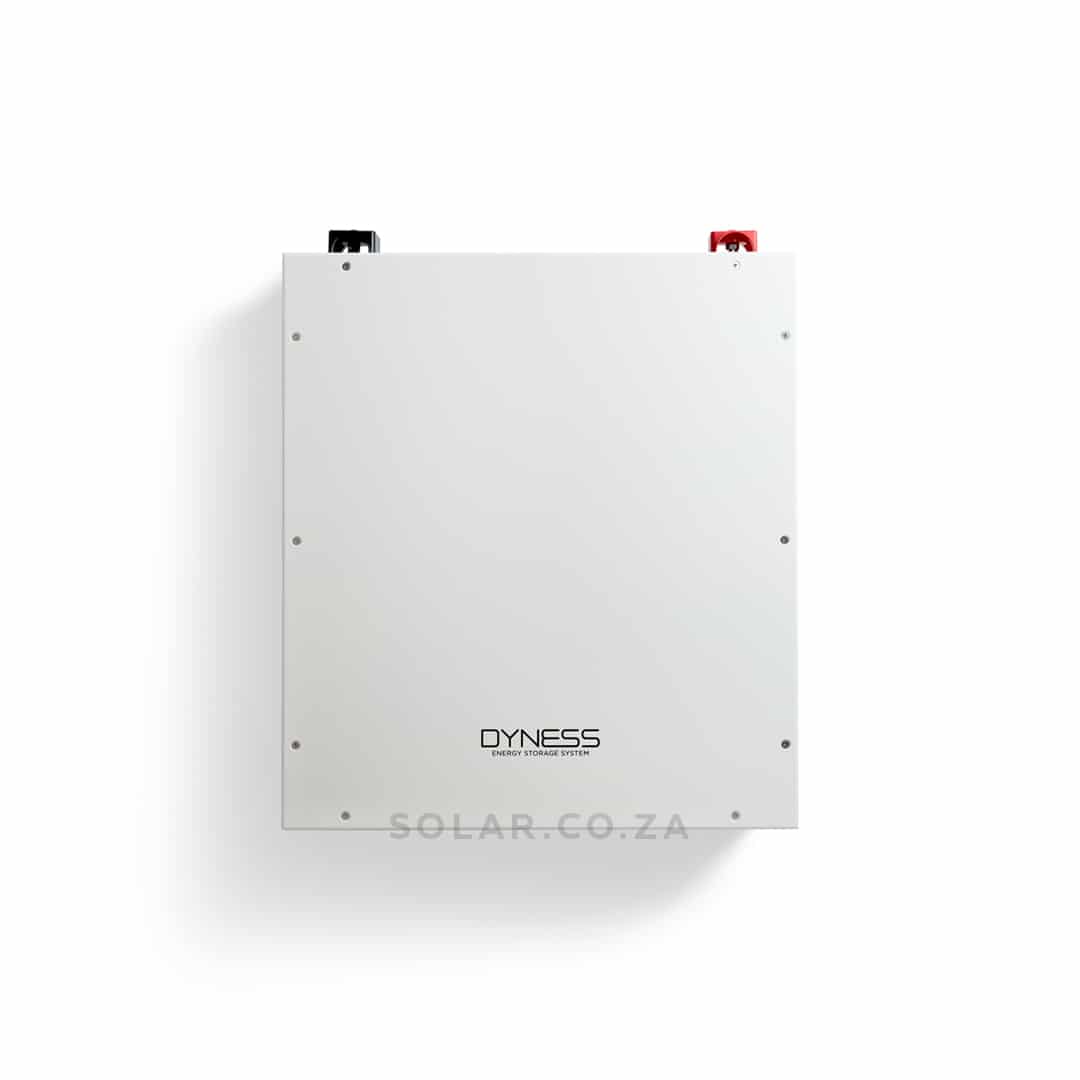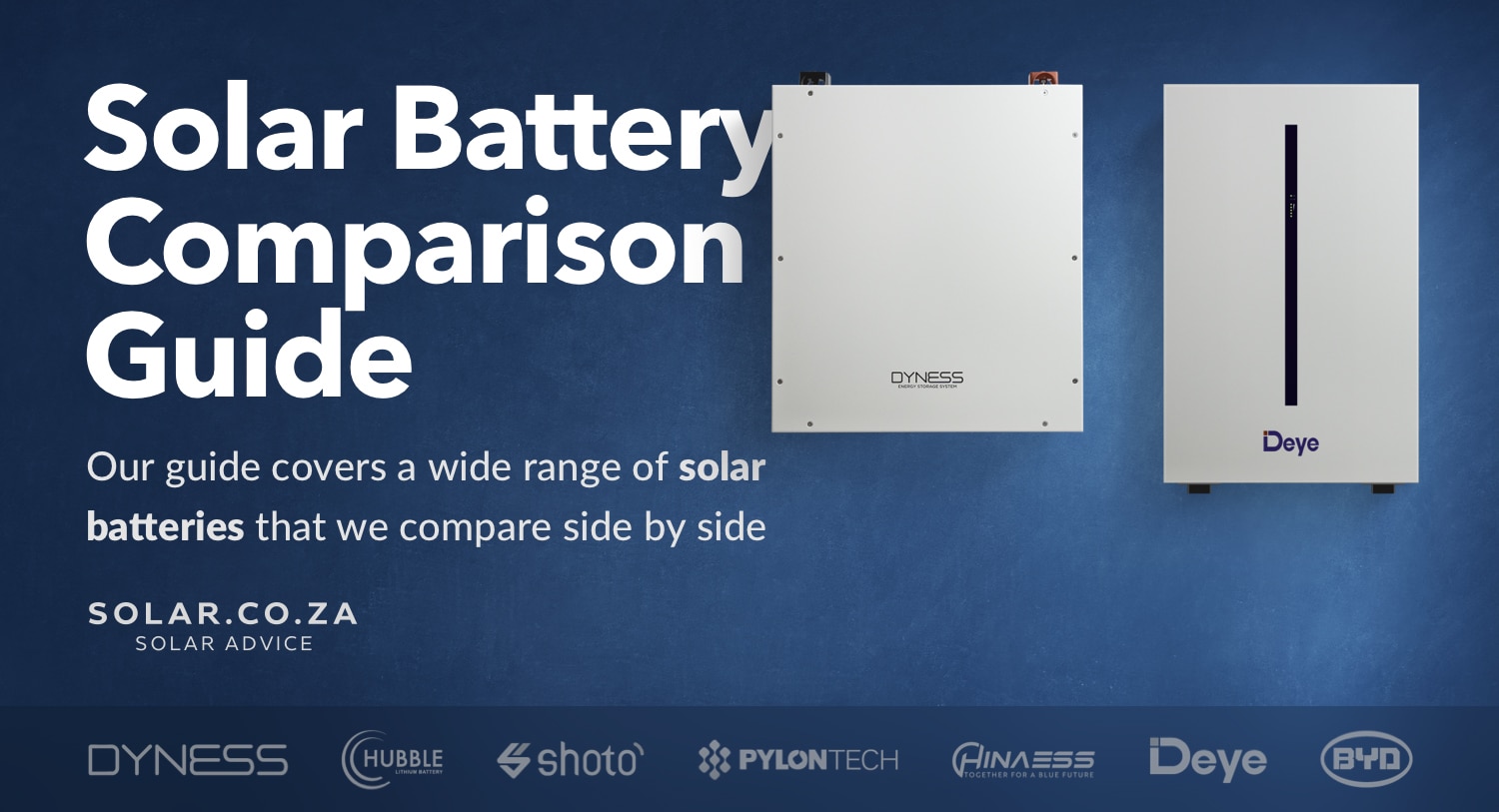Our Solar Battery Comparison guide aims to compare popular Lithium-ion batteries and find the best solar battery. We look at several features but ultimately want to find the battery with the best specs at an affordable price.
Choosing a battery bank is a vital part of your journey to gaining energy independence. But, at the beginning of your solar journey, you may not know what to look for. With so many battery types available, it can be difficult to choose one.
The best types of solar batteries are lithium solar battery systems. They have longer life spans, require no maintenance and are easily installed and monitored via your inverter.
The answer may not be all that simple. However, here are seven things you should look at:
- Number of cycles
- Depth of discharge (DOD)
- C rating (discharge rate in kWh)
- How far can you expand your battery bank
- Mounting type
- Price point
- Warranty
A battery bank performs a key role with in a Solar Power Kit, storing the solar energy produced by your solar panels.
Chapter 1
Solar Battery Comparison: The Fundamentals
Before delving into the comparison portion of this article, it’s essential to understand what some of the solar lingo means. If you’re proficient in your solar knowledge, you may want to skip this section as you will already know these terms.
Number of Cycles
The number of cycles is the number of times a battery can be charged and discharged. One cycle is one full charge and discharge.
The average home with a Solar Power Kit will cycle its battery 1 – 2 times daily, especially in winter. You’ll cycle your battery once a day or less during the summer months.
It’s important to mention that battery manufacturers usually specify the number of cycles. However, recently, some manufacturers have reported “unlimited cycles”. But these manufacturers still have a limited warranty of 10 years, so you get an unlimited number of cycles within the ten-year warranty period.
If you cycle your battery once a day for ten years, this will give you 3560 odd cycles. If you cycle your battery twice a day during the winter months and once a day during summer, that total is 5340 cycles.
Depth of Discharge
DOD refers to how much of the battery is usable. A battery with a DOD of 80% means that your usable capacity is 80% of the rated power.
C Rating
The C rating tells you what the battery’s maximum discharge rate is. A 0.5c rated battery can discharge at 50% of its rated power. While a 1c rated battery can discharge at its full rated power.
Mounting Types
There are three solar battery mounting types: wall, floor and rack-mounted. We go through the advantages and applications for the different mounting types further down in this article.
Chapter 2
Solar Battery Comparison: Lithium-ion Battery Data Comparison
To make comparing the solar batteries we and many other suppliers stock easy, here is a side-by-side comparison. This list includes the seven data points listed in the introduction.
The following 48v batteries are among some of the most popular and cost effect in residential energy storage systems in South Africa.
| Lithium-ion Solar Battery Comparison | |||||||
|---|---|---|---|---|---|---|---|
| Battery | Cycles | DOD | C Rating | Parallel | Mounting | Price | Warranty |
| Dyness 3.6kWh | 6000 | 80% | 0.5 | 40 | Rack | R 17,825.00 | 10 Years |
| HinaESS 5.12kWh | 6000 | 90% | 1 | 32 | Rack | R 21,850.00 | 10 Years |
| PylonTech 3.5kWh | 6000 | 95% | 0.5 | 16 | Rack | R 21,275.00 | 7-10 Years |
| Dyness 4.8kWh | 6000 | 80% | 0.5 | 15 | Wall | R 21,275.00 | 5 Years |
| Shoto 5.12kWh | 5000 | 90% | 1 | 20 | Rack | R 21,712.00 | 5 Years |
| Dyness 5.12kWh | 6000 | 80% | 0.5 | 16 | Wall | R 21,983.40 | 5 Years |
| PylonTech 4.8kWh | 4500 | 95% | 0.5 | 16 | Rack | R 25,300.00 | 5 Years |
| Deye 6.4kWh | 6000 | 90% | 0.5 | 32 | Wall/Floor | R 31,482.40 | 10 Years |
| Hubble 5.5kWh AM2 | *3000/6000 | *100%/50% | 1 | 8 | Wall/Rack | R 31,193.97 | 10 Years |
| BYD 5kWh | 6000 | 100% | 1 | 64 | Rack | R 37,375.00 | 10 Years |
Chapter 3
Solar Battery Comparison: Solar Battery Life Span
Knowing how long you can expect your chosen battery to last is vital. And to do this, we look at the number of cycles and, in some cases, the warranty period.
The number of cycles of the battery determines the life span of the battery.
Realistically, you’ll be looking at cycling your battery bank once a day, maybe twice maximum. Here is a comparison breakdown of how long each battery bank will last based on their specified life cycles. I’ll include one and two cycles per day to depict how long a Lithium-ion battery bank will last accurately.
| Lithium-ion Solar Battery Cycles | |||||||
|---|---|---|---|---|---|---|---|
| Number of Cycles / by 1 Year (365 days) | Life Expectancy | Number of Cycles / by 2 Years (730 days) | Life Expectancy | ||||
| 6000 cycles / 356 days | 16.44 Years | 6000 cycles / 730 days | 8.22 Years | ||||
| 5000 cycles / 356 days | 13.70 Years | 5000 cycles / 730 days | 6.85 Years | ||||
| 4500 cycles / 356 days | 12.33 Years | 4500 cycles / 730 days | 6.16 Years | ||||
Chapter 4
Solar Battery Comparison: Depth of Discharge
As explained above, the depth of discharge (DOD) relates to what percentage of your battery’s power rating is usable. Lead acid batteries typically have a DOD of 50%, while Lithium-ion batteries have a DOD of 80-100%
Below, we’ll take a look 3 batteries with different DODs.

Dyness Block
Storage Capacity: 5.12kWh
DOD: 80%
Usable Capacity: 4.1kWh

Deye
Storage Capacity: 6.4kWh
DOD: 90%
Usable Capacity: 5.76kWh

BYD
Storage Capacity: 5kWh
DOD: 100%
Usable Capacity: 5kWh
Chapter 5
Solar Battery Comparison: C Rating
A battery with a 1C rating can handle appliances that produce a high energy spike when turned on. Usually, these are your heating appliances. Having this extra discharge capacity will prevent your system from tripping.
If you want to be as close to off-grid as possible, a 1C battery is recommended. Below you’ll find our 1C batteries.

HinaESS 5.12kWh Lithium-ion Battery
R 21,850.00
Shoto 5.12kWh Lithium-ion Battery
R 21,712.00
Hubble 5.5kWh Lithium-ion Battery
R 31,193.97
BYD 5kWh Lithium-Ion Battery
R 37,375.00Chapter 6
Solar Battery Comparison: Future Expansion
Households grow to include new family members, more appliances etc. And so our demand for extra battery storage grows too. Knowing how flexible your battery bank is, is critical to choosing the correct battery for your home.
Parallel
This is where knowing how many batteries you can add to your system comes in handy. We call this “parallel”, which you can find on your battery’s datasheet.
The average home should cope with load shedding and nightly cycling with a 5kWh lithium-ion battery. However, you may want to add to your battery bank to increase your coverage.
Oversizing your battery bank is a good idea. It will prevent overuse of your batteries, allowing them to last longer and reducing the frequency of buying new ones.

Chapter 7
Solar Battery Comparison: Battery Mounting Types
There are two main types of battery mounting. But finding the correct battery heavily depends on where you intend to install your battery bank.
We’ll review the mounting types below and which spaces best suit them.
Wall-Mounted
Wall mounted batteries are excellent space savers because they are mounted next to or below your solar inverter. This keeps your battery bank out of the way and protects them from damage.
Wall-mounted batteries are perfect for:
- Single garages
- In-home installations
- Homes with little space
They also make for a neat-looking solar installation, so they are perfect for anyone with wall space.


Rack-Mounted
Rack-mounted batteries are incredibly versatile due to their small size and easy installation and expansion. However, these batteries need a 1mx1m floor space for the battery cabinet.
Rack-mounted batteries are perfect for:
- Large garages
- Dedicated room/store room
- Homes with lots of space
Neat, stylish cabinets are available for select rack-mounted brands. These cabinets are handy for keeping your battery bank safe from dust, debris, and foot traffic.
Chapter 8
Solar Battery Comparison: Pricing & Warranties
our battery bank is undoubtedly the most costly part of your solar system. But how much you get out of your battery bank determines what it costs you.
The warranty period needs to be considered too. Ranging from 5-10 years, you’ll want to ensure you are well covered if something happens to your batteries.
Some brands offer more cycles and a more extended warranty period. Some brands offer a standard warranty that can be extended by registering your solar battery.
In this chapter, we’ll show you that while the upfront payment can seem expensive, your solar lithium-ion battery can cost you very little per cycle.
| Lithium-ion Solar Battery Cost per Cycle | |||||
|---|---|---|---|---|---|
| Battery | Price | Cost per kWh | Cycles | Cost per Cycle | Warranty |
| Dyness 3.6kWh | R 17,825.00 | R5,497.78 | 6000 | R1.15 | 10 Years |
| HinaESS 5.12kWh | R 21,850.00 | R4,155.27 | 6000 | R0.77 | 10 Years |
| PylonTech 3.5kWh | R 21,275.00 | R6,597.34 | 6000 | R1.16 | 7-10 Years |
| Dyness 4.8kWh | R 21,275.00 | R5,030.47 | 6000 | R1.05 | 5 Years |
| Shoto 5.12kWh | R 21,712.00 | R4,896.46 | 5000 | R1.09 | 5 Years |
| Dyness 5.12kWh | R 21,983.40 | R4,973.78 | 6000 | R1.04 | 5 Years |
| PylonTech 4.8kWh | R 25,300.00 | R5,772.67 | 4500 | R1.35 | 5 Years |
| Deye 6.4kWh | R 31,482.40 | R5,257.26 | 6000 | R0.97 | 10 Years |
| *Hubble 5.5kWh AM2 | R 31,193.97 | R6,616.00 | 3000/6000 | R2.21/R1.10 | 10 Years |
| BYD 5kWh | R 37,375.00 | R7,574.65 | 6000 | R1.21 | 10 Years |
Chapter 9
Solar Battery Comparison: Best Overall
We’ve seen an increase in the storage capacity sizes of solar batteries over the years, which ultimately help reduce the upfront costs involved.
Lithium batteries are perfectly designed to store energy for when you need to use them and provide continuous power to your home as we deal with the load shedding crisis.
Here are the top runners considering the 7 data aspects we discussed in the introduction:
Best Rack-Mounted Battery Overall
HinaESS 5.12kWh Lithium-ion Battery
Cost Per Cycle: R0.77
6000 Cycles
90% DOD
1C
32 Units in Parallel
10 Year Warranty
R 21,850.00









